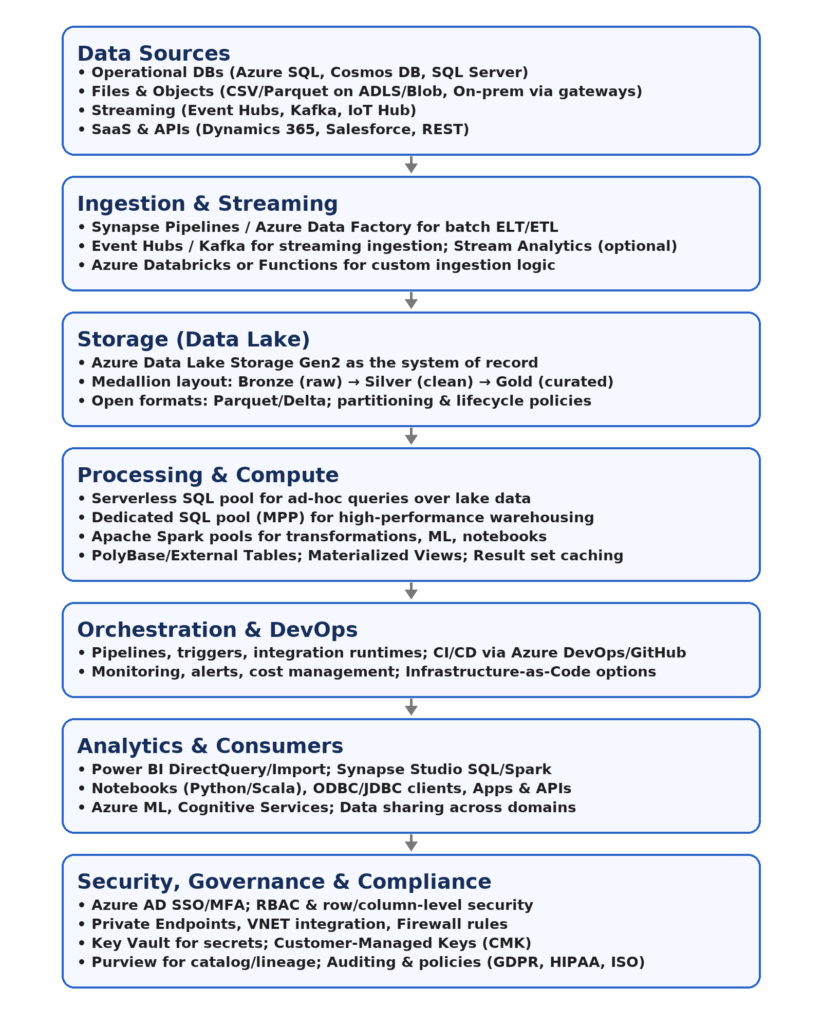Introduction
As organizations increasingly rely on data to drive decision-making, the demand for cloud-based analytics platforms has surged. Among the leading solutions is Azure Synapse Analytics, Microsoft’s flagship cloud data warehouse. Formerly known as Azure SQL Data Warehouse, Synapse has evolved into a comprehensive analytics service that unifies enterprise data warehousing, big data integration, and real-time analytics into a single platform.
What is Azure Synapse Analytics?
Azure Synapse Analytics is a fully managed cloud data warehouse designed for scalable, high-performance analytical workloads. It combines the familiarity of SQL-based querying with advanced capabilities for big data, machine learning, and business intelligence. Synapse enables organizations to ingest, prepare, manage, and serve data for immediate business intelligence and predictive analytics.
Unlike traditional warehouses that are rigid and costly to scale, Synapse leverages the elasticity of the cloud, allowing organizations to scale compute and storage independently and on-demand.
Key Features of Azure Synapse
1. Elastic Scalability
- Compute and storage resources are decoupled, enabling independent scaling.
- Organizations can provision high performance for peak workloads and scale down during quiet periods to optimize costs.
2. Integrated Analytics
- Synapse seamlessly integrates with Azure Data Lake Storage, allowing enterprises to combine structured and semi-structured data in analytics workflows.
- It supports both serverless on-demand queries and dedicated SQL pools, giving flexibility in balancing cost and performance.
3. Tight Integration with the Microsoft Ecosystem
- Power BI for visualization and business dashboards.
- Azure Machine Learning for predictive modeling and AI.
- Azure Data Factory for orchestrating ETL pipelines.
- Microsoft Purview for data governance and cataloging.
This deep integration makes Synapse a natural fit for enterprises already invested in Microsoft Azure.
4. Performance at Scale
- Uses massively parallel processing (MPP) to handle large datasets efficiently.
- Employs columnar storage and data distribution strategies to accelerate query execution.
5. Security and Compliance
- Features encryption at rest and in transit, as well as advanced identity and access management.
- Complies with major regulatory standards including GDPR, HIPAA, SOC, and ISO certifications.
6. Hybrid and Multi-Source Data Support
- Supports querying external data directly in Azure Data Lake or from operational databases.
- Enables organizations to blend cloud-native and on-premises data sources in a unified platform.
Common Use Cases
- Business Intelligence (BI):
Organizations use Synapse to centralize data and provide real-time dashboards via Power BI. - Data Lakehouse Architecture:
By combining with Azure Data Lake Storage, Synapse serves as the query and analytics layer of a modern “lakehouse” solution. - Advanced Analytics and AI:
Data scientists leverage Synapse with Azure ML and notebooks to develop predictive models directly from warehouse data. - Operational Reporting:
Enterprises automate reporting pipelines and reduce latency in operational insights.
Strengths of Azure Synapse Analytics
- Deep integration with the Microsoft Azure ecosystem.
- Flexible compute models (serverless and dedicated).
- Familiar SQL interface for existing database teams.
- Strong governance and compliance features.
- Scales efficiently to petabytes of data.
Challenges and Considerations
- Learning curve: Organizations must adapt to Synapse’s hybrid query model (serverless vs. dedicated).
- Cost management: While flexible, costs can rise without governance, especially with serverless queries over massive datasets.
- Competition: Rivals like Snowflake and Google BigQuery offer strong multi-cloud and simplified pricing models.
Conclusion
Azure Synapse Analytics stands out as a powerful, enterprise-ready cloud data warehouse that bridges traditional data warehousing with the agility of big data and AI. For organizations already committed to the Microsoft ecosystem, Synapse provides unmatched integration, scalability, and security.
As data-driven decision-making becomes a competitive necessity, Synapse empowers enterprises to harness the full potential of their data—from historical reporting to advanced AI-driven insights.
